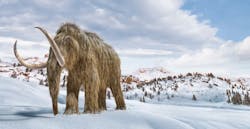When the United Nations met this month, COVID-19 and Afghanistan were not the only critical topics. Ahead of the UN Climate Change Conferences scheduled for October 31 to November 12, climate change was front and center in most of the delegates minds. Interestingly, while the diplomats were debating and discussing this important issue, at least one scientist is looking at the Ice Age for answers.
Colossal Laboratories & Biosciences, founded by Ben Lamm, who calls himself a “serial technology entrepreneur driven to solve the most complex challenges facing our planet” and Harvard and MIT professor George Church, Ph.D., has raised $15 million for their efforts to create an elephant-woolly mammoth hybrid. Of course, woolly mammoths became mostly extinct some 10,000 years ago (we say “mostly” because there were still a few on Russia's remote Wrangel Island in the Arctic Sea, some 4,000 years ago). About the size of an African elephant, the woolly mammoth was well-adapted to the cold. Covered in two layers of fur, with short ears and tails, their limited exposed skin helped to reduce heat loss and avoid frostbite. Like modern-day elephants, the wooly mammoth used its tusks to fight and its trunk to smell, breathe, trumpet, drink, and move and hold objects.
Colossal’s plan is to make embryos in the laboratory that carry mammoth DNA, using cells from Asian elephants that are edited using gene editing tools such as CRISPR. The genes specifically responsible for the cold weather adaptations, such as the fur and fat layers, would be identified and used to produce a resistant elephant that looks and behaves like a woolly mammoth. The concept is to de-extinct the mammoths and help prevent extinction of the endangered Asian elephants.
So if you’re asking what this has to do with climate change, Colossal’s plan is to populate large portions of the Arctic – the mammoth steppe – with herds of these elephant-mammoth hybrids. During the Ice Age, the mammoth steppe was completely snow-covered during the winter, and its high albedo (in our industry, it’s white roofs to reduce the urban heat island effect) resulted in a delayed spring thaw. The mammoths knocked down trees to forage for leaves, and once they were gone, the steppe became a tall sun-catching forest. Since there was not enough snow cover to reflect the sunlight, the spring thaws came sooner. The theory is that if the re-populated mammoth-like elephants can knock down those trees, the once-prevalent Arctic grasses, herbs, and shrubs (the mammoth steppe was once the planet’s most extensive biome) could be restored.
This is undoubtedly the only climate change adaptation strategy that comes with a warning to avoid getting trampled by the herd!
##########
A regular contributor to HPAC Engineering and a member of its editorial advisory board since 2012, Larry Clark, LEED AP, O+M, is a principal at Sustainable Performance Solutions LLC, a south Florida-based engineering firm focusing on energy and sustainability. Email him at [email protected].
About the Author
Larry Clark
A member of HPAC Engineering’s Editorial Advisory Board, Lawrence (Larry) Clark, QCxP, GGP, LEED AP+, is principal of Sustainable Performance Solutions LLC, a South Florida-based engineering firm focused on energy and sustainability consulting. He has more than two dozen published articles on HVAC- and energy-related topics to his credit and frequently lectures on green-building best practices, central-energy-plant optimization, and demand-controlled ventilation.
